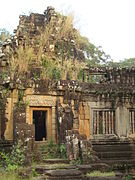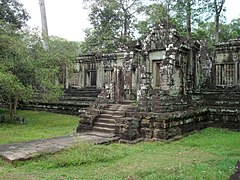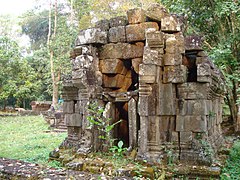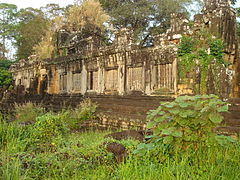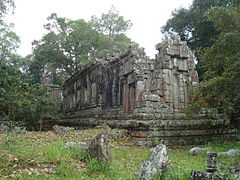
Khmer architecture, also known as Angkorian architecture, is the architecture produced by the Khmers during the Angkor period of the Khmer Empire from approximately the later half of the 8th century CE to the first half of the 15th century CE.

Angkor, also known as Yasodharapura, was the capital city of the Khmer Empire. The city and empire flourished from approximately the 9th to the 15th centuries. The city houses the Angkor Wat, one of Cambodia's most popular tourist attractions.
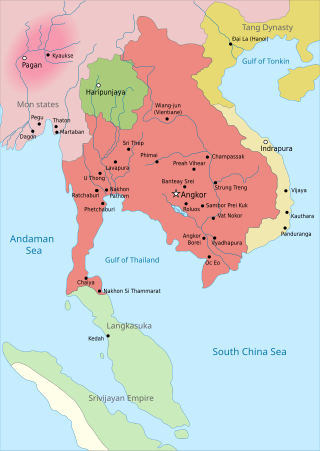
The Khmer Empire was a Hindu-Buddhist empire in Southeast Asia, centered around hydraulic cities in what is now northern Cambodia. Known as Kambuja by its inhabitants, it grew out of the former civilisation of Chenla and lasted from 802 to 1431. Historians call this period of Cambodian history the Angkor period, after the empire's most well-known capital, Angkor. The Khmer Empire ruled or vassalised most of mainland Southeast Asia and stretched as far north as southern China. At its peak, the Empire was larger than the Byzantine Empire, which existed around the same time.
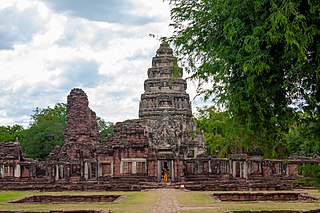
The Phimai Historical Park is a historical park in Thailand, covering the ancient town of Phimai and the ruins of Prasat Phimai Thai: ปราสาทพิมาย, pronounced[prāː.sàːtpʰí(ʔ).māːj]) the largest ancient Khmer-Hindu temple in Thailand. It is located in the town of Phimai, Nakhon Ratchasima province. It is one of the most important tourist attractions in the province.

Angkor Thom, alternatively Nokor Thom, located in present-day Cambodia, was the last and most enduring capital city of the Khmer Empire. It was established in the late twelfth century by King Jayavarman VII. It covers an area of 9 km², within which are located several monuments from earlier eras as well as those established by Jayavarman and his successors. At the centre of the city is Jayavarman's state temple, the Bayon, with the other major sites clustered around the Victory Square immediately to the north. The site is one of the major tourist attractions of Southeast Asia.

The Bayon is a richly decorated Khmer temple related to Buddhism at Angkor in Cambodia. Built in the late 12th or early 13th century as the state temple of the King Jayavarman VII, the Bayon stands at the centre of Jayavarman's capital, Angkor Thom.

Ta Keo is a temple-mountain in Angkor (Cambodia), possibly the first to be built entirely of sandstone by the Khmer Empire.

Banteay Kdei, also known as "Citadel of Monks' cells", is a Buddhist temple in Angkor, Cambodia. It is located southeast of Ta Prohm and east of Angkor Thom. Built in the mid-12th to early 13th centuries AD during the reign of Jayavarman VII, it is in the Bayon architectural style, similar in plan to Ta Prohm and Preah Khan, but less complex and smaller. Its structures are contained within two successive enclosure walls, and consist of two concentric galleries from which emerge towers, preceded to the east by a cloister.

Thommanon is one of a pair of Hindu temples built during the reign of Suryavarman II (1113–1150) at Angkor, Cambodia. This small and elegant temple is east of the Gate of Victory of Angkor Thom and north of Chau Say Tevoda. It is part of the UNESCO World Heritage Site, inscribed by UNESCO in 1992 titled Angkor. The temple is dedicated to Shiva and Vishnu.

Phimeanakas or Vimeanakas at Angkor, Cambodia, is a Hindu temple in the Khleang style, built at the end of the 10th century, during the reign of Rajendravarman, then completed by Suryavarman I in the shape of a three tier pyramid as a Hindu temple. On top of the pyramid there was a tower, while on the edge of top platform there are galleries. Phimeanakas is located inside the walled enclosure of the Royal Palace of Angkor Thom north of Baphuon.

Suryavarman I was king of the Khmer Empire from 1006 to 1050. Suryavarman usurped King Udayadityavarman I, defeating his armies in approximately 1002. After a protracted war with Udayadityavarman's would-be successor, Jayavirahvarman, Suryavarman I claimed the throne in 1010. Suryavarman was a Mahayana Buddhist who was also tolerant of the growing Theravada Buddhist presence in the Khmer kingdom.

Preah Palilay is a temple at Angkor, Cambodia. It is located in Angkor Thom, 400 m north-west of Phimeanakas. This small Buddhist sanctuary in the wooded area north of the Royal palace in Angkor Thom has a number of attractive features and is well worth the short detour.

Preah Pithu is a group of five temples at Angkor, Cambodia. In fact they were in all probability not designed as a group. Despite their ruined state, the remains have good decorative carving and their semi-wooded setting is attractive and peaceful.

Koh Ker is a remote archaeological site in northern Cambodia about 120 kilometres (75 mi) away from Siem Reap and the ancient site of Angkor. It is a jungle filled region that is sparsely populated. More than 180 sanctuaries were found in a protected area of 81 square kilometres (31 sq mi). Only about two dozen monuments can be visited by tourists because most of the sanctuaries are hidden in the forest and the whole area is not fully demined.

Siem Reap is the second-largest city of Cambodia, as well as the capital and largest city of Siem Reap Province in northwestern Cambodia.
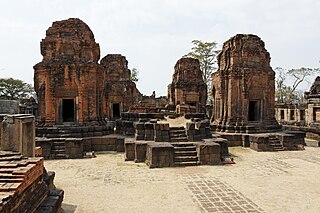
Prasat Muang Tam is a Khmer Hindu Temple in Prakhon Chai District, Buriram Province, Thailand. It is primarily in the Khleang and Baphuon styles, which dates its primary phases of construction to the late-10th and early-11th centuries. The primary deity was Shiva, although Vishnu was also worshipped there.
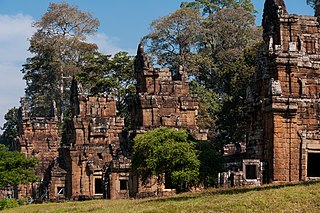
Prasat Suor Prat is a series of twelve towers spanning north to south lining the eastern side of a royal square in Angkor Thom, near the town of Siem Reap, Cambodia. The towers are made from rugged laterite and sandstone. They are right in front of Terrace of the Elephants and Terrace of the Leper King, flanking the start of the road leading east to the Victory Gate, on either side of which they are symmetrically arranged. Their function remains unknown.

Sambor Prei Kuk (Isanapura) is an archaeological site in Cambodia located in Kampong Thom Province, 30 km (19 mi) north of Kampong Thom, the provincial capital, 176 km (109 mi) east of Angkor and 206 km (128 mi) north of Phnom Penh. The now ruined complex dates back to the Pre-Angkorian Chenla Kingdom, established by king Isanavarman I as central royal sanctuary and capital, known then as "Isanapura". In 2017, Sambor Prei Kuk was declared a UNESCO World Heritage Site.
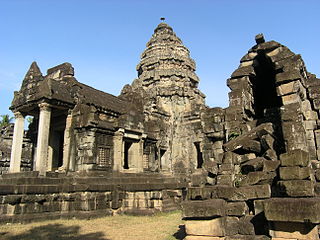
Wat Althea, also called Prasat Vat Althea, is a 12th-century Hindu temple at Angkor, Cambodia with an active Buddhist temple and cemetery adjacent to the walled ancient structure.

Prasat Ta Muen Thom or Prasat Ta Moan Thom'RTGS: Prasat Ta Muean Thom, pronounced[prāːsàːttāːmɯ̄a̯ntʰōm]) is a Khmer temple located on Cambodian-Thai border.


